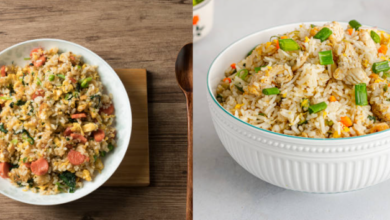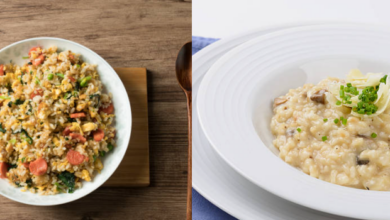Ready for a Rice Challenge? Try Malaysian and Chinese Fried Rice and Decide Which is Best!

What To Know
- One of the defining characteristics of Malaysian fried rice is the use of budu, a fermented anchovy sauce that imparts a unique savory and slightly fishy flavor.
- Malaysian fried rice often includes shrimp, chicken, or a combination of both, while Chinese fried rice can feature a wider variety of proteins, including pork, beef, and seafood.
- Malaysian fried rice is flavored with a combination of budu, shrimp paste, and aromatic herbs, while Chinese fried rice is typically seasoned with soy sauce, oyster sauce, and sesame oil.
Fried rice, a staple dish in many Asian cuisines, is a culinary delight that has captured the hearts and taste buds of people worldwide. In the realm of fried rice, two culinary giants stand out: Malaysian fried rice and Chinese fried rice. Both dishes share the common foundation of rice, vegetables, and protein, yet they offer distinct flavor profiles and cooking techniques that set them apart. This blog post embarks on a culinary journey to explore the captivating differences between Malaysian fried rice and Chinese fried rice, highlighting their unique ingredients, cooking methods, and the cultural influences that shape their flavors.
Malaysian Fried Rice: A Symphony of Fragrant Herbs and Bold Flavors
Malaysian fried rice is a vibrant and flavorful dish that reflects the diverse culinary heritage of Malaysia. It is typically prepared using fragrant jasmine rice, which is stir-fried with a medley of aromatic herbs, spices, and an assortment of ingredients. Common additions include shrimp, chicken, vegetables like carrots and green beans, and a generous helping of sambal, a spicy chili paste that adds a fiery kick to the dish.
One of the defining characteristics of Malaysian fried rice is the use of budu, a fermented anchovy sauce that imparts a unique savory and slightly fishy flavor. This ingredient adds depth and complexity to the dish, making it a favorite among those who appreciate bold and umami-rich flavors.
Chinese Fried Rice: A Timeless Classic with Regional Variations
Chinese fried rice, on the other hand, is a culinary staple that has been enjoyed in China for centuries. It is characterized by its use of medium- or long-grain rice, which is stir-fried with a variety of ingredients, including vegetables, meat, seafood, and eggs. The dish is often seasoned with soy sauce, oyster sauce, and a touch of sesame oil, resulting in a savory and slightly sweet flavor profile.
Chinese fried rice is known for its versatility, with regional variations across the vast country. Some popular variations include Yangzhou fried rice, which features an array of ingredients like shrimp, chicken, and vegetables, and Sichuan fried rice, which is characterized by its spicy and numbing flavors.
Comparing the Ingredients and Cooking Techniques:
- Rice: Malaysian fried rice typically uses fragrant jasmine rice, while Chinese fried rice can be made with medium- or long-grain rice.
- Protein: Malaysian fried rice often includes shrimp, chicken, or a combination of both, while Chinese fried rice can feature a wider variety of proteins, including pork, beef, and seafood.
- Vegetables: Both Malaysian and Chinese fried rice commonly use vegetables like carrots, green beans, and onions. However, Malaysian fried rice may also include unique ingredients like pineapple and sambal.
- Seasonings: Malaysian fried rice is flavored with a combination of budu, shrimp paste, and aromatic herbs, while Chinese fried rice is typically seasoned with soy sauce, oyster sauce, and sesame oil.
- Cooking Technique: Both dishes are stir-fried, but Malaysian fried rice is often cooked over a higher heat to create a slightly charred and smoky flavor.
The Cultural Influences:
- Malaysian Fried Rice: The flavors of Malaysian fried rice reflect the country’s diverse cultural heritage, with influences from Malay, Chinese, and Indian cuisines. The use of budu and shrimp paste adds a distinctly Southeast Asian touch to the dish.
- Chinese Fried Rice: Chinese fried rice is a reflection of China’s vast culinary landscape, with regional variations that showcase the diverse flavors and ingredients found across the country. The use of soy sauce and oyster sauce is a testament to the importance of these condiments in Chinese cooking.
Which One is Better? A Matter of Personal Preference:
The debate over which fried rice is better, Malaysian or Chinese, is subjective and ultimately depends on personal taste preferences. Both dishes offer unique flavor profiles and culinary experiences. Malaysian fried rice captivates with its bold and spicy flavors, while Chinese fried rice offers a more versatile and savory taste.
Beyond the Basics: Variations and Accompaniments:
Both Malaysian and Chinese fried rice offer endless possibilities for variations and accompaniments. Experimenting with different ingredients, sauces, and garnishes can create a personalized and unique fried rice experience. Some popular variations include:
- Malaysian Fried Rice Variations: Nasi Goreng Kampung (Malaysian Village Fried Rice), Nasi Goreng Pattaya (Thai-inspired Fried Rice), Nasi Goreng Ikan Bilis (Fried Rice with Anchovies).
- Chinese Fried Rice Variations: Yangzhou Fried Rice, Sichuan Fried Rice, Cantonese Fried Rice, Hokkien Fried Rice.
- Accompaniments: Fried rice is often served with a variety of accompaniments, such as pickled vegetables, crispy shallots, and fried eggs.
“Fried Rice Face-Off”: A Culinary Celebration:
To celebrate the culinary delights of Malaysian and Chinese fried rice, food festivals and competitions are held worldwide. These events bring together chefs and food enthusiasts to showcase their skills and creativity in preparing these iconic dishes.
Key Points:
Malaysian fried rice and Chinese fried rice stand as two culinary treasures that have captivated taste buds across the globe. Their distinct flavors, ingredients, and cooking techniques reflect the rich cultural heritage of their respective countries. Whether you prefer the bold and spicy flavors of Malaysian fried rice or the versatile and savory taste of Chinese fried rice, one thing is certain: both dishes offer a delightful culinary journey that is sure to satisfy and inspire.
FAQ:
- Q: What is the key difference between Malaysian and Chinese fried rice?
A: Malaysian fried rice is characterized by its use of fragrant jasmine rice, budu, and shrimp paste, while Chinese fried rice uses medium- or long-grain rice and is seasoned with soy sauce, oyster sauce, and sesame oil.
- Q: Which fried rice is spicier?
A: Malaysian fried rice is generally spicier due to the use of budu and sambal, which add a fiery kick to the dish.
- Q: Can I use regular white rice for Malaysian fried rice?
A: While regular white rice can be used, it is recommended to use fragrant jasmine rice for a more authentic Malaysian fried rice experience.


